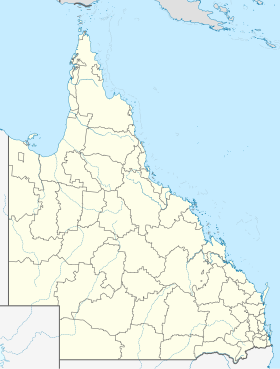Bethania (Queensland)
| Bethania | |||||||
|---|---|---|---|---|---|---|---|
 Deutsche Einwandererfamilie auf ihrer Farm, vermutlich in der Gegend von Bethania im Logan-Distrikt, 1872. Bemerkenswert ist die Person rechts mit einem Teleskop. | |||||||
| |||||||
| |||||||
| |||||||
| |||||||
Bethania ist ein Vorort von Brisbane mit 5385 Einwohnern (Stand 2016)[1]. Er liegt etwa 25 Kilometer südlich des Stadtzentrums am Logan River. Der Ort hieß ursprünglich Bethanien und sein Name wurde im Alltagsleben angepasst.
Bethania wurde von deutschen Immigranten im 19. Jahrhundert gegründet. Die Regierung im australischen Queensland beauftragte John Heussler, den Immigrationagenten, die deutsche Besiedlung zu organisieren. In Kooperation mit der Reederei Joh. Ces. Godeffroy & Sohn kamen 1864 deutsche Aussiedler von Hamburg aus nach Australien und gründeten Bethanien. Innerhalb weniger Jahre bauten 200 Siedler eine lutherische Kirche und eine Schule auf und erstellten einen Friedhof. Der Ort hatte einen Schmied, Stellmacher und weitere Handwerker.
1887 wurde der Ort durch den Logan River überflutet. 1949 erfolgte der Ausbau des Vorortes, eine Lutheran Primary School entstand und das Bethania Waters Shopping Centre wurde 1986 erbaut. Es gibt eine State Primary School und Community Centre.[2]
Transport
1885 wurde eine Eisenbahnverbindung von der South Coast nach Beenleigh eröffnet, die von Logan Village bis nach Bethania führte. Die Station wurde Bethania Junction bis in die 1940er Jahre genannt. Bethania kann mit dem Citytrain von Brisbane und von Beenleigh aus erreicht werden.
Weblinks
Einzelnachweise
- ↑ a b Bethania. 2016 Census Quickstat. Australian Bureau of Statistics, 27. Juni 2017, abgerufen am 13. April 2020 (englisch).
- ↑ queenslandplaces.com: Bethania, in englischer Sprache, abgerufen am 30. November 2011
Auf dieser Seite verwendete Medien
Flag of Australia, when congruence with this colour chart is required (i.e. when a "less bright" version is needed).
See Flag of Australia.svg for main file information.State flag and government ensign (internal waters only) of Queensland.
FIAV 110010.svg:
German immigrant family on their farm, probably in the Bethania area, Logan district, 1872
The early part of William Boag's career was spent in Sydney where he was in partnership with portrait photographer Joseph Charles Milligan. (Images made by Boag are in the collection of the Campbelltown and Airds Historical Society.). Boag arrived in Queensland in November 1871. He travelled around the south-east, along the foreshore of Moreton Bay and the township of Cleveland. He then moved into the Logan and Albert area where he captured images of local crushing mills and sugar plantations. While at Yatala, he took on a partner, John Henry Mills, and by the end of 1872, both men were in Stanthorpe where they remained for several months, producing views of the booming tin-mining settlement. In July 1873, after stopping off in Warwick, Boag and Mills extended their operations to Mackay, where they remained until October 1875. During this time, Boag made trips to St Lawrence and Cooktown, however his movements after this are difficult to trace. It is known that by mid 1876 he was at Copperfield and Clermont, and in February 1878, he inserted a notice in the Peak Downs Telegram announcing that he was leaving for the west. Then information ceases abruptly. It is possible that Boag never reached his destination, since his death certificate records that he died in 1878 at an unknown location. The first major German settlement occurred on the Logan River in 1864, when a group of 20 families of the Lutheran Free Church of Prussia established themselves on part of the extended Logan Agricultural Reserve (centering on what later became the town of Bethania). By 1867, two other associated settlements had been established further down the river - at 'Philadelphia' (Eagleby) and 'Elkana' (Alberton). All took up blocks of scrubland, establishing farms of between 30-80 acres and turning their attention to field crops such as maize, pumpkin, arrowroot and potatoes.
Their northern European heritage was reflected in a unique type of architecture, of which a good example is this half-timbered 'barn'. Grain was stacked in the top storey, while the farmer's family probably lived below. Note the telescope displayed incongruously on a chair at far right in the photograph. Boag's patrons saw his visits as a means of documenting not just their own likenesses, but of affirming their place in the world by recording their most precious and personal possessions,.Autor/Urheber: NordNordWest, Lizenz: CC BY-SA 3.0 de
Positionskarte von Queensland, Australien




